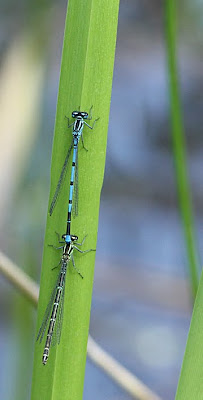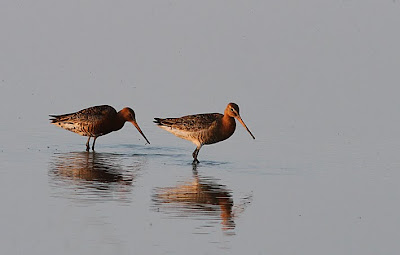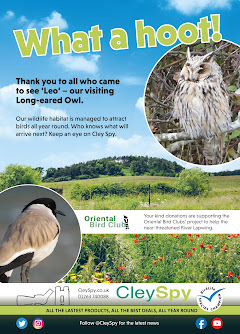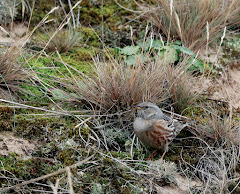Emperor Dragonfly, Sculthorpe Moor.
I have never photographed a kingfisher properly. Well I have distant records shots, but nothing spectacular at all. I am told that Lackford Lakes is one of the best places to see/photograph kingfishers, so must visit this reserve one day. Anyway I decided to go back to Sculthorpe in hope of catching that Kingfisher (see yesterday's post) just for a couple of hours before moving on to Kelling and Cley.
Sculthorpe Moor Nature Reserve
Arrived at Sculthorpe Moor Nature Reserve at 8am which is when it officially opens. You can't cheat and go before as there are locked security gates with cameras! I was very pleased to be first on the reserve and especially before the sun got any hotter! There were several blackcaps, both male and female whilst walking along the board walk to the Wader Scrape Hide (where the kingfisher was seen yesterday afternoon). The sun felt hot already! The reed beds were alive with sedge and reed warblers and reed buntings sitting on hawthorn bushes, calling. Sitting in the hide I could see four young lapwing chicks today! A heron flew across and there were teal and mallard on the water. Loads of swifts and swallows skimming over the water continuously whilst I sat there. I realised, that like Titchwell RSPB, Redwell Marsh NOA and Cley NWT, that this scrape is best viewed in the afternoon, as the sun was streaming through the hide and also made it incredibly hot! Several young pied wags were flicking about on the muddy edges along with sedge and reed warblers and a goldfinch posed on the fence just below the hide window (see pic) A grand Emperor Dragonfly cruised around the pool, along with loads of broad-bodied chasers, including one that sat on a stem just below the hide, as did the Emperor for a moment! (see pic). A sedge warbler posed on the fence momentarily. Met some more lovely people in the hide a bit later, including Gorden Hamlet and wife Chris. One of the things I LOVE about this reserve is that NO dogs are allowed, which is just such a joy - no barking dogs, no dogs scaring the hell of me, and no owners shouting at them and also you can enjoy observing everything around you without having to look where you are treading! Magic! The reserve is well designed and alot of thought has been put into the reserve down to the outside loo available after the centre closes at 5pm. They have planted a nature garden outside the front of the reception centre, which held several interesting insects yesterday. The entire reserve is boardwalk, so is wheel chair friendly apart from the last section to the wader scrape hide. But my guess is, that it too will be board walk eventually. They are continuously working on improving the reserve and are extending the reedbeds this winter I am told. The reserve is open from 8am to dusk see here for details. Anyway, no sign of the kingfisher after two hours and I was gasping for air now. Left the hide and strolled back. When I reached the long dyke I put my camera bag etc down on a seat opposite a cut away area in the reeds. I spent ages here watching an Emperor Dragonfly patrolling up and down the dyke, which was continuously harrassed by four-spotted chasers! Also had wonderful views of one of my favourites, a single Banded Demoiselle which did not land for my camera. I was hoping the Emperor would land and waited ages for it to do so - it did eventually, but for a moment only, just long enough though, for me to snap a few pics - they are not prize winning shots as a bit too distant, but I was happy I got something. I also witnessed, along with a few other people something amazing for the first time - an Emperor dragonfly catching and flying along with a small white butterfly, which seemed to slow it down as it flew, but then suddenly dropped it and the butterfly escaped seemingly unharmed!!!! Won't forget that! It was seriously hot whilst I stood here, no shade in this section of the reserve, which is obviously why the dragons were happy! There were also several damselflies here of which I have yet to ID from my pictures. A kestrel sat nearby in a tree. Butterflies seen today were: loads of meadow browns, ringlets, comma, small tortoiseshell, red admiral, large skippers, speckled woods and whites.

Left this area and diverted off along the boardwalk towards the Woodland Hide area. At the seat that reads "Old Gits' Corner" I sat down for a while and enjoyed this wonderfully shady spot. Opposite the seat is a open area with several bird feeders and table and had a continuous stream of birds visiting the nuts and seed including a juv. robin, marsh, blue, great tits, chaffinches and a blackbird whilst I was there. The sunlight also streams through the tall trees and is a very pretty spot to sit. An older man called Bob walked up to me who knows my father and was kindly asking after him. We were chatting away when suddenly we spotted a massive, striking black and yellow ringed dragonfly which looked as I said at the time 'loads bigger than an Emperor'. It flew powerfully and with a straight body (if that makes sense). It looked like a big cinnabar moth caterpillar with wings!!!!!! It was flying quite high around the trees over the bird feeders and then came down and landed on a bramble for a second and then across to the opposite side and landed. Now, you are obviously not supposed to walk off the board walk and especially not to the feeders and I seriously wish now that I had broken that rule immediately rather than waiting to say to Bob, 'do you object if I walk in there to photograph that?' to which he replied 'no I don't mind'. I walked towards the bird feeders, too many seconds too late and realised it was not in view anymore - I looked and looked and to my disbelief it had gone! As Victor Meldrew said "I don't believeeeeee it!!! I waited a good while to see if it came back again and also walked back up the board walk in case it had moved along. I also asked everyone else I passed if they had seen it. I sat looking on the internet on iphone, as at this point I had no idea what it was. Phoned Pete S. who was out in the field and said that 'Emperor' was the biggest dragonfly and phoned my parents who were mystified at what I had seen. I thought about Southern Hawker, but it was too big for that and much more striking etc. Back at the reception centre I spoke to a very helpful lady who allowed me to look at the internet with her in the office and combined with looking at their dragonfly chart I concluded that the only thing it could have been was a female Golden Ringed Dragonfly which IS larger than Emperor!!! BUT has only been recorded in Norfolk in the broads once according to here hmmmmm..... but why not!!!?
Sat and had my lunch in the picnic area and managed to find a small area of shade on the grass - just about got my bottom on it! (ha ha) Could not stop thinking about that dragonfly - another one that got away!
Bumped into Bob again in the reception centre who had watched the dragonfly with me and I said 'describe what you saw again' to the lady in reception and besides the exact description I have already given, he added 'put it this way, I wouldn't have wanted it to collide with my head'
After my lunch I persevered and went back to 'Old Gits' Corner' and spent at least another couple of hours here - I was so disappointed that I had not been able to photograph that dragonfly!!!
I should have gone home at 7.30pm when I left this reserve, but I didn't want to go home. Crazy bird!





Cley-next-Sea NWT Reserve
Arrived at Cley and walked to Daukes' Hide. I am so glad I did. I have never seen so many birds from the hide in the most beautiful light. Eddie M. was in the hide also. There were 10 Spoonbills on 'Billy's Wash' 12 Little Gulls sitting around, but I could only see 10. A kestrel flew in and sat on the hide roof (see pic). 2 Ruff, loads of black-tailed godwits, lapwings, avocets, a green sandpiper, spotted redshank, marsh harriers, barn owl, gulls and just loads of usual waders in brilliant orangy sunlight. Eddie also pointed out a curlew sandpiper to me. The black tailed godwits almost looked red! Oh and a nice sandwich tern sat on an island, surrounded by black headed gulls. Loads of cormorants flew over the hide, a bit too quick for the camera though, they suddenly appeared from nowhere! It was a nice way to end the day and also heard some wonderful tales from Eddie about some of his expeditions abroad! Left the hide at 9.45pm, needless to say I arrived home very late - too late to have the energy to write my blog up!





























































Hi Penny. My name's Tim James and I was with you when we saw the Emperor take the butterfly. What a moment. We then spoke in the Sculthorpe car park about the Golden Ringed Dragonfly. I'm so pleased it all seems to be shaping up as a really good spot on your part. BTW, on my own blog I've posted some images of the Four-spotted Chasers (including the three-winged one) doing much of the territorial dogfighting while we watched. Why not take a look at http://the-gray-gallery.blogspot.com/ and then follow so we can keep in touch. All best, Tim (Holt)
ReplyDeleteHi Tim! It certainly was 'a moment' when the Emperor took the butterfly! Will have a look at your blog/gallery tomorrow. Got back late this evening after looking for an Icterine Warbler at Titchwell RSPB - in vain!
ReplyDeleteAnyone know what this [plant] is?
ReplyDeleteBistort
Penny, your Damselflies are Azure Damsels.
ReplyDeleteJohn
I think the beetle maybe a species of Longhorn (Cerambycidae sp.) the plant is Redshank (Persicaria maculosa) and the wasp is one from the spider hunting lot (Arachnospila sp.) I believe.
ReplyDeleteAll the best,
Rob
Bistort and redshank are both genus persicaria. P maculosa has black markings on the leaves. Not sure from photo.
ReplyDeleteThe longhorn bettle I believe is leptura quadrifaciata. There are similar black and yellow species.
Hi Penny
ReplyDeleteLooks like Water Pepper for the mystery plant
David